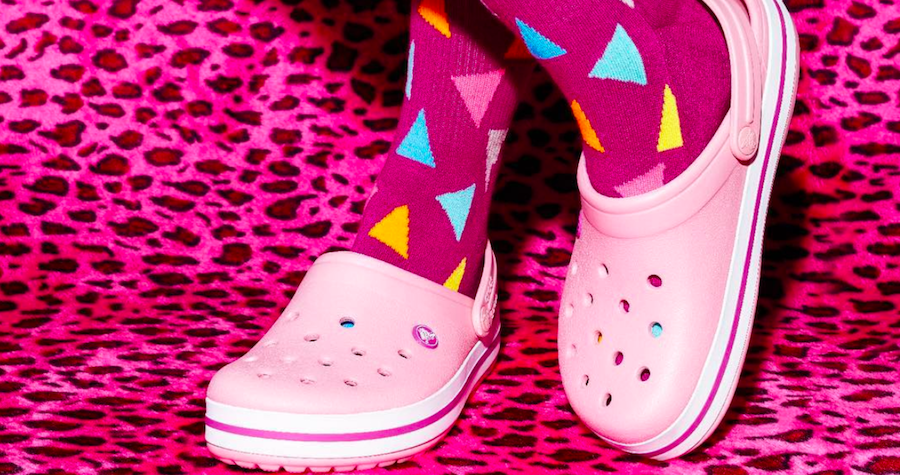While Crocs’ third quarter showed that its bottom-line continues to benefit from cost-cutting initiatives and a focus on higher-margin sales, top-line growth remains a struggle and management inferred that sales would be flat in 2018.
On its third-quarter conference call with analysts, Andrew Rees, president and CEO, said the company’s cost-reduction program is “yielding very tangible and significant progress, but ultimately, we need to get the top line moving.”
Rees said he has “more confidence’ around Crocs’ product with its narrower focus on clogs and sandals and its recent marketing efforts are resonating as well. He also noted that growth was seen in the third quarter in the Americas, up 5.0 percent, and in Europe, up 6.2 percent, but “went backwards” in Asia, which was down 12 percent, due to strategic changes in the region.
Added Rees, “As we get through those changes, we think that we can start to build the top line and drive growth in the brand and the revenue for the overall company.”
Carrie Teffner, CFO, added that sales gains are being impacted by efforts to shift to a “quality revenue base” by reducing its amount of sales sold at a discount. She added, “Getting out of this low margin business, making sure that what we are selling is profitable that’s a better place to grow from. And so part of that challenge is essentially getting through 2018 for the most part in terms of that headwind we faced from that cleanup. That said, we continue to improve profitability while we do that.”
In the third quarter, the net loss was reduced to $2.3 million, or 3 cents a share, from $5.4 million, or 7 cents, in the same period a year ago. Results exceeded Wall Street’s consensus target of a 5 cent a share loss.
Sales were down 1.1 percent to $243.3 million, exceeding the top-end of its guidance that called for sales between $230 and $240 million. On a currency-neutral basis, revenues decreased 1.6 percent.
The dip in sales was due to store closures and business model changes, specifically last year’s fourth quarter sale of its Taiwan business and this year’s second quarter sale of its Middle East business. Excluding these moves, revenues would have been relatively flat.
Wholesale revenues declined 2.2 percent primarily due to the changeover in Taiwan and the Middle East.
Direct-to-consumer (DTC) comps rose 7.0 percent. At retail, comps inched up 0.4 percent. Overall retail sales declined 7.2 percent as Crocs operated 80 fewer stores versus the year-ago period. It closed the quarter with 474.
E-commerce revenues jumped 25.2 percent over last year’s third quarter with double-digit comps in each region.
Crocs sold 13.1 million pairs in the quarter, a 7.5 percent increase from the prior year. The average selling price of footwear was $18.17, down 9 percent as its product and channel mix continues to change.
In the Americas, revenue was $120.5 million, up 5.1 percent, with growth in each channel. Wholesale revenues grew 0.6 percent with improved profitability as Crocs focused on “higher quality revenue and had limited excess and end-of-life inventory,” said Teffner. Americas DTC comp increased 9.2 percent, retail comp was up 2.8 percent and retail sales increased 1.4 percent despite having 12 less stores compared to last year’s third quarter. E-commerce sales increased 28.5 percent.
In Asia, sales were down 12 percent to $80 million. Wholesale declined 10 percent due to the sale of the Taiwan business and a focus on higher-margin accounts. Japan was impacted by the closing of single branded stores with a shift to a multi-brand model typical of other global brands in the region. Retail sales declined 20.8 percent reflecting 61 fewer full-priced stores year-over-year and a 2.9 comp decline. E-commerce increased 17.8 percent and overall DTC comp growth was 3.7 percent.
In Europe, sales grew 6.2 percent to $42.5 million. Wholesale revenues increased 8.9 percent primarily due to improved FX rates. DTC comp growth was 4.8 percent. Retail sales declined 5.8 percent as a result of a 2.1 percent comp decline and operating with 10 fewer stores. E-commerce sales jumped 26.2 percent.
Companywide gross margin was 50.8 percent, an increase of 100 basis points over last year’s third quarter. Gross margin was expected to be flat. The improvement reflected Crocs’ focus on core molded product and its continued focus on inventory management that resulted in higher quality revenue.
SG&A improved 70 basis points as overall expenses were reduced 2.2 percent. The latest includes $3.6 million of charges relating to its SG&A reduction plan. Income from operations reached $2.7 million compared to last year’s third quarter loss of $1.2 million.
Operationally, Rees noted on the call that Crocs was able to reduce inventories by 17.2 percent year over year. The company is also on plan to eliminate between $75 million and $85 million of SG&A expenses annually and to deliver an incremental $30 million to $35 million in income from operations in 2019 as compared to 2016. Said Rees, “These results continue to demonstrate that by focusing on our key strategic objectives, we are improving our financial performance and moving closer to our objective of generating double-digit EBIT margins.”
On top-line growth, Rees believes the brand’s narrowed focus on clogs, along with greater attention to sandals, flips and slides will ultimately pay off. Said Rees, “Based on year-to-date results and the positive response we are seeing to our spring summer 2018 line, we know that this narrowed focus is working well for the brand.”
Clogs represented 52 percent of sales, up from 51.5 percent. New colors and graphics, embellishments and licensed images drove growth with the Classic and Crocband continuing to be its best sellers.
Sandals grew to represent 18.6 percent of sales, up from 13.8 percent, driven by its Swiftwater, Isabella, Sloane and Sandro styles. Said Rees, “Our broad-based offerings satisfy multiple wearing occasions and appeal to consumers with different style preferences. At the same time, they are comfortable, lightweight and trend white reflecting our key brand attributes.”
For Spring 2018, a key launch will be LiteRide, featuring a proprietary new material that offers “an extremely lightweight, highly cushioned footbed, while introducing simple modern styling.”
For fall this year, Crocs is benefiting from reducing the number of cold weather styles and encouraging stores to sell clogs and sandals deeper into the fall season.
On the branding/marketing front, Crocs’ annual brand survey showed double-digit gains in brand desirability, brand relevance and brand consideration “demonstrating that our new product and marketing initiatives are resonating with consumers.” Paying off in marketing is its Come As You Are campaign, launched in April; amplified efforts around social and digital; and PR generated from its Christopher Kane and Balenciaga collaborations.
Overall, Rees highlighted that e-commerce delivered a double-digit growth in the quarter across all three geographic regions with the help of new leadership. Retail performed in line with expectations with progress being made in rationalizing its store fleet.
Wholesale continues to feel the impact of business model changes, particularly in Asia. Rees added, “At the same time, ongoing accounts continue to be pleased with the performance they are experiencing, highlighted by strong sell-throughs at good margins. This is leading to SKU and door expansion. In addition, clogs and sandals are being sold longer into the fall season with our Always Summer initiative.”
He concluded, “The third quarter was another strong quarter for us, both in terms of our financial performance and the progress we have made against our strategic initiatives. We have a strong Spring/Summer ‘18 collection and are excited about year two of our Come As You Are marketing campaign. Ongoing operational improvements will lead to greater efficiencies as we continue to focus on our SG&A cost reduction plan. We remain committed to delivering significant improvements in shareholder value in the coming years.”
Looking ahead, Crocs reiterated its outlook for the year. Revenues are expected to be down low-single digits. Gross margin is projected to be approximately 50 percent. SG&A is expected to range between $490 and $495 million, including approximately $10 million of charges associated with its SG&A reduction plan.
For the fourth quarter, sales are expected to range between $180 and $190 million, which compares to $187.4 million a year ago. Gross margin is expected to reach approximately 43 percent, or up 100 basis points year-over-year. SG&A is expected to be $115 million, including $2 million of charges associated with its SG&A reduction plan, and representing a reduction of $3 million year-over-year.
Photo courtesy Crocs
















